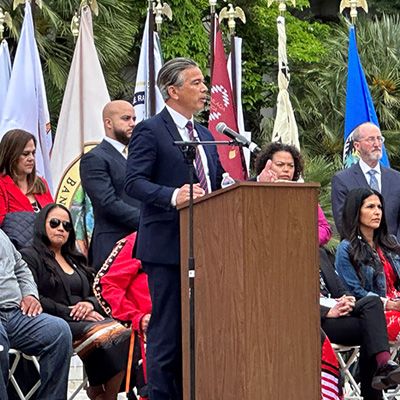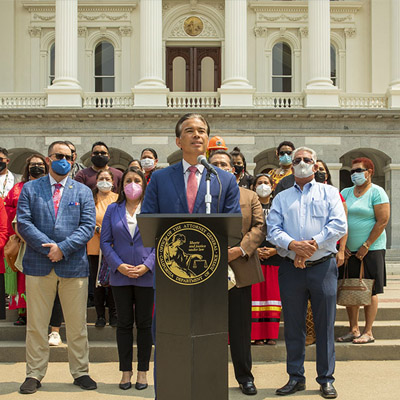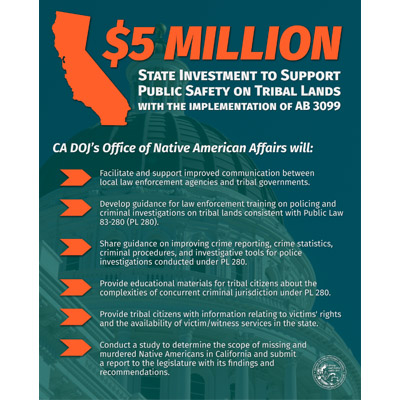
AB 3099 – Tribal Assistance Program Implementation
What is the Tribal Assistance Program – AB 3099?
California’s Reponse to the Missing Murdered Indigenous Persons (MMIP) Crisis and the Inconsistent Implementation of PL 280 on Indian Lands
California Assembly Bill 3099 (AB 3099) calls for the California Department of Justice to provide training and guidance to law enforcement agencies and tribal governments to help reduce uncertainty regarding criminal jurisdiction and improve public safety on tribal lands. The new effort also includes funds to study challenges related to the reporting and identification of missing and murdered Native Americans in California, particularly women and girls. California is home to more people of Native American and Alaskan Native heritage than any other state in the country — with approximately 176 California Native American Tribes and a little over 100 separate tribal reservations.
In 1953, Congress enacted Public Law 83-280 (PL 280), expressly transferring criminal jurisdiction over most crimes committed by or against Native Americans on tribal land from the federal government to designated states, including California. As a result, California and tribal governments share concurrent criminal jurisdiction — with the federal government in limited circumstances — on tribal lands in the state. Although PL 280 has been in existence for almost 70 years, its requirements and implications often remain confusing among state, local, and tribal authorities. Generally, the complexity of PL 280 can and has led to public safety uncertainty and frustration among tribal communities and their neighbors. AB 3099 highlights the importance of providing for the consistent application of PL 280 through education, training, technical assistance, and increased coordination among California’s sovereign tribal governments and local authorities in the 34 California counties that touch on tribal lands.
AB 3099 also calls for the California Department of Justice to conduct a study to determine how to increase state criminal justice protective and investigative resources for reporting and identifying missing Native Americans in California. Numerous studies have already highlighted concerns among tribal nations regarding the number of missing Native Americans, both reported and unreported, across the United States, particularly women and girls. For instance, based on data from the National Crime Information Center Missing Person File, American Indians, Alaska Natives, Native Hawaiians, and Pacific Islanders combined made up the second highest number of reported missing persons in 2018, despite making up the smallest portion of the U.S. population. However, given many of the existing jurisdictional challenges, clear data on the scope of the issue in California remains limited. According to the Federal Bureau of Investigation, there were approximately 1,496 active end-of-year missing persons cases out of a total of 9,575 reports for American Indian and Alaska Natives across the United States in 2020.
In order to help address these challenges, AB 3099 works to fill the gaps by establishing the Tribal Assistance Program within the California Department of Justice’s Office of Native American Affairs. The law requires the new program over a period of five years, among other things, to:
- Develop guidance for law enforcement training on policing and criminal investigations on tribal lands consistent with PL 280;
- Provide educational materials geared towards tribal citizens about the complexities of concurrent criminal jurisdiction under PL 280, including information relating to victims’ rights and the availability of services in the state;
- Share guidance on improving crime reporting, crime statistics, criminal procedures, and investigative tools for police investigations conducted under PL 280;
- Facilitate and support improved communication between local law enforcement agencies and tribal governments; and
- Conduct a study to determine the scope of the issue of missing and murdered Native Americans in California, identifying barriers to reporting and ultimately issuing recommendations to the State Legislature.
Link: https://leginfo.legislature.ca.gov/faces/billTextClient.xhtml?bill_id=201920200AB3099
For more information, please see the following resources:

5/17/23 MMIP Interview with AG Bonta
CA Attorney General Rob Bonta on Missing and Murdered Indigenous Peoples (MMIP) Crisis

8/17/21 Press Conference
Attorney General Bonta, Legislative Leaders Highlight Major Investment Aimed at Supporting Public Safety on Tribal Lands

8/17/21 Press Release
AG Bonta, Asm. Ramos Highlight $5 Million State Investment Aimed at Supporting Public Safety on Tribal Lands
What has been the Federal Response to the MMIP Crisis?
In April of 2022, The U.S. Department of Justice launched the Missing or Murdered Indigenous Persons (MMIP) webpage as part of its Tribal Justice and Safety website. This page houses U.S. DOJ Tribal initiatives such as the Tribal Access Program, grant opportunities, consultations, as well as several other tribal resources, and details the Department’s efforts to address the disproportionately high rates of violence and missing persons cases amongst Native Americans.
To learn more, please visit: https://www.justice.gov/tribal/mmip.
The federal government has initiated several key programs related to MMIP, including:
U.S. Attorney General’s Initiative on Missing and Murdered Indigenous PeopleOn November 22, 2019, then attorney General William P. Barr introduced the Attorney General’s MMIP Initiative. This collaboration effort, led by U.S. Attorney’s the Federal Bureau of Investigation (FBI), and the Office of Tribal Justice, is supported by the Office of Justice Programs and the Office on Violence Against Women. The initiative comprises three main components:
- Appointing MMIP coordinators in U.S. Attorney’s Offices across 11 states with significant tribal populations (Alaska, Arizona, Montana, Oklahoma, Michigan, Utah, Nevada, Minnesota, Oregon, New Mexico, and Washington) to develop localized protocols for handling missing and murdered Indigenous cases.
- Rapid deployment of specialized FBI teams to assist law enforcement agencies with missing persons cases as needed.
- Conducting comprehensive data analyses to enhance missing persons reporting.
For more information, please visit: https://www.justice.gov/opa/pr/attorney-general-william-p-barr-launches-national-strategy-address-missing-and-murdered
Not Invisible Act and Not Invisible Act ComissionThe Not Invisible Act, introduced and passed by four U.S. congressional members enrolled in their respective tribes and signed into legislation in 2020, is led by Department of the Interior Secretary Deb Haaland. The Act requires the establishment of the Not Invisible Act Commission, a cross jurisdictional advisory committee comprised of federal partners, law enforcement, tribal leaders, service providers, family members of missing and murdered individuals, and survivors.
A few recommendations on behalf of the commissions to address public safety challenges identified in the Act, include:
- Identifying, reporting and responding to missing and murdered indigenous peoples (MMIP) and human trafficking cases.
- Tracking and reporting MMIP and human trafficking data.
- Developing necessary legislative and administrative changes for federal programs, properties, and resources to combat MMIP and human trafficking crisis.
On November 1, 2023, the Not Invisible Act Commission submitted their full list of recommendations to the Department of Justice and the Interior and to Congress. As required in the Act, the Department of Justice and Department of the Interior have issued a response to the provided recommendations.
For more information, please visit: https://www.justice.gov/tribal/not-invisible-act
Department of the Interior’s Missing and Murdered UnitOn April 1, 2021, Interior Secretary Deb Haaland announced the creation of a Missing & Murdered Unit (MMU) within the Bureau of Indian Affairs Office of Justice Services. This Unit aims to coordinate federal resources and enhance investigations of missing and murdered American Indians and Alaska Natives across various agencies and within Indian Country.
For more information, please visit: https://www.doi.gov/priorities/missing-and-murdered-indigenous-peoples
Roundtable DiscussionsThe virtual roundtable discussions are organized as a part of the federal response to the recommendations to the Not Invisible Act Commission to combat violent crimes on Indian lands and against American Indian and Alaska Native people. The Commission recommended the Justice Department and Department of Interior hold a roundtable discussion to attempt to develop a set of best practices to support the large masses of ignored and unsolved cases; with large concern for lack of media coverage for MMIP and human trafficking cases by individuals affected by the crisis.
The Departments plan to publish the best practices stemming from this roundtable discussion by the end of 2024.
For more information, please visit: https://www.justice.gov/opa/pr/readout-departments-justice-and-interior-roundtable-media-coverage-missing-or-murdered